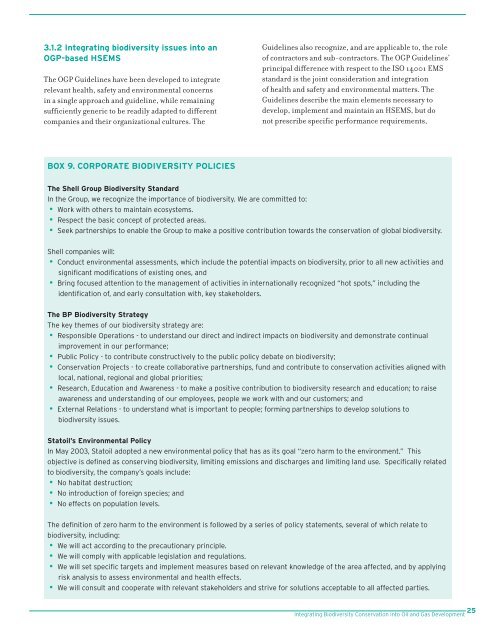Integrating Biodiversity Conservation into Oil and Gas ... - EBI
Integrating Biodiversity Conservation into Oil and Gas ... - EBI
Integrating Biodiversity Conservation into Oil and Gas ... - EBI
Create successful ePaper yourself
Turn your PDF publications into a flip-book with our unique Google optimized e-Paper software.
3.1.2 <strong>Integrating</strong> biodiversity issues <strong>into</strong> an<br />
OGP-based HSEMS<br />
The OGP Guidelines have been developed to integrate<br />
relevant health, safety <strong>and</strong> environmental concerns<br />
in a single approach <strong>and</strong> guideline, while remaining<br />
sufficiently generic to be readily adapted to different<br />
companies <strong>and</strong> their organizational cultures. The<br />
Guidelines also recognize, <strong>and</strong> are applicable to, the role<br />
of contractors <strong>and</strong> sub-contractors. The OGP Guidelines’<br />
principal difference with respect to the ISO 14001 EMS<br />
st<strong>and</strong>ard is the joint consideration <strong>and</strong> integration<br />
of health <strong>and</strong> safety <strong>and</strong> environmental matters. The<br />
Guidelines describe the main elements necessary to<br />
develop, implement <strong>and</strong> maintain an HSEMS, but do<br />
not prescribe specific performance requirements,<br />
BOX 9. CORPORATE BIODIVERSITY POLICIES<br />
The Shell Group <strong>Biodiversity</strong> St<strong>and</strong>ard<br />
In the Group, we recognize the importance of biodiversity. We are committed to:<br />
• Work with others to maintain ecosystems.<br />
• Respect the basic concept of protected areas.<br />
• Seek partnerships to enable the Group to make a positive contribution towards the conservation of global biodiversity.<br />
Shell companies will:<br />
• Conduct environmental assessments, which include the potential impacts on biodiversity, prior to all new activities <strong>and</strong><br />
significant modifications of existing ones, <strong>and</strong><br />
• Bring focused attention to the management of activities in internationally recognized “hot spots,” including the<br />
identification of, <strong>and</strong> early consultation with, key stakeholders.<br />
The BP <strong>Biodiversity</strong> Strategy<br />
The key themes of our biodiversity strategy are:<br />
• Responsible Operations - to underst<strong>and</strong> our direct <strong>and</strong> indirect impacts on biodiversity <strong>and</strong> demonstrate continual<br />
improvement in our performance;<br />
• Public Policy - to contribute constructively to the public policy debate on biodiversity;<br />
• <strong>Conservation</strong> Projects - to create collaborative partnerships, fund <strong>and</strong> contribute to conservation activities aligned with<br />
local, national, regional <strong>and</strong> global priorities;<br />
• Research, Education <strong>and</strong> Awareness - to make a positive contribution to biodiversity research <strong>and</strong> education; to raise<br />
awareness <strong>and</strong> underst<strong>and</strong>ing of our employees, people we work with <strong>and</strong> our customers; <strong>and</strong><br />
• External Relations - to underst<strong>and</strong> what is important to people; forming partnerships to develop solutions to<br />
biodiversity issues.<br />
Statoil’s Environmental Policy<br />
In May 2003, Statoil adopted a new environmental policy that has as its goal “zero harm to the environment.” This<br />
objective is defined as conserving biodiversity, limiting emissions <strong>and</strong> discharges <strong>and</strong> limiting l<strong>and</strong> use. Specifically related<br />
to biodiversity, the company’s goals include:<br />
• No habitat destruction;<br />
• No introduction of foreign species; <strong>and</strong><br />
• No effects on population levels.<br />
The definition of zero harm to the environment is followed by a series of policy statements, several of which relate to<br />
biodiversity, including:<br />
• We will act according to the precautionary principle.<br />
• We will comply with applicable legislation <strong>and</strong> regulations.<br />
• We will set specific targets <strong>and</strong> implement measures based on relevant knowledge of the area affected, <strong>and</strong> by applying<br />
risk analysis to assess environmental <strong>and</strong> health effects.<br />
• We will consult <strong>and</strong> cooperate with relevant stakeholders <strong>and</strong> strive for solutions acceptable to all affected parties.<br />
25<br />
<strong>Integrating</strong> <strong>Biodiversity</strong> <strong>Conservation</strong> <strong>into</strong> <strong>Oil</strong> <strong>and</strong> <strong>Gas</strong> Development
















![[PDF] Community Development Toolkit - CommDev](https://img.yumpu.com/48616495/1/184x260/pdf-community-development-toolkit-commdev.jpg?quality=85)
